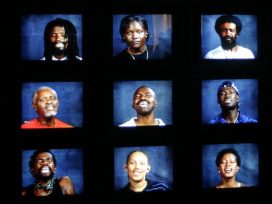Any overview of a country’s contemporary literature throws up an inescapable paradox. The works that serve as the best examples in any account of “the current situation” are rarely the most artistically convincing. These representative books draw their strength precisely from the fact that they are so representative – from the ease with which reviewers can draw obvious parallels between literature and its directly political, social, or whatever, context. It is these titles, too, that attract the most attention at the time of publication. They are ripe subjects for media debates and are keenly discussed by commentators who have not read them but are more than happy to express opinions on them, since the concepts they contain are familiar and topical.
One example was Sisela Lindblom’s novel De skamlösa (The shameless, 2007), which, in conjunction with an interview with the author, sparked off the “cultural debate” of last autumn. It was all about handbags. Immensely expensive designer bags as symbols of an absurd consumer culture. The question of whether it can be considered reasonable to spend 40 000 Swedish kronor (approx. 4000 euros) on a handbag became a frame of reference for everything from globalization to gender perspectives.
The novel itself, which was not at all bad and had a number of other dimensions to offer, remained unread by most contributors to the debate.
The book overshadowing all else in Sweden this spring was dramatist Lars Norén’s En dramatikers dagbok (Diary of a playwright, 2008). This was a very thick volume with unnumbered pages and a black cover, criticising and calling to account many well-known Swedish cultural figures including critics, colleagues and actors. Although it was primarily concerned with how the Swedish dramatist, second only to Ingmar Bergman in international fame, approaches and executes his work, the discussion naturally focused on Norén’s attacks on the intellectual establishment. This was only to be expected.
Although if the truth be told, it was not even that aspect which continued to occupy the commentators once the initial storm had blown over. No, it was the fact that Lars Norén’s diary revealed his weakness for expensive suits.
Handbags, however, are not his thing. As far as we know.
The whiff of scandal around Norén’s diary was also in evidence in the great talking point of last autumn: Maja Lundgren’s semi-autobiographical novel Myggor och tigrar (Gnats and tigers, 2007), in which she drew parallels between the Neapolitan Camorra and the patriarchal structure of the Swedish cultural elite. Lundgren had two novels behind her, and several years on the arts pages of the leading evening daily Aftonbladet. In her new novel she revealed that she had had an extra-marital affair with the arts editor of the paper and revelled in exposés of a large number of other well-known players on the Swedish cultural scene.
Many of her targets protested, produced documents contradicting the book’s version of events, and generally helped to create the perception that the author of the novel was a borderline mental case who should have been gagged by her publisher for her own good. Just a year later, however, we can note that the official gender-theory line has prevailed, and Lundgren’s self-exposure is widely viewed as yet more documentary evidence of how the patriarchy abuses and silences women.
There you have, in a nutshell, the big Swedish literary debates of the past year. Other than that, the public side of literary Sweden is characterised by occasional, sleazy little spats, usually between big-selling writers of popular fiction and literary authors. In recent years Sweden as a nation has become a not insignificant exporter of crime fiction to the rest of Europe and that fact – together with the reduction of VAT on books a few years ago – has afflicted popular writers with incomes in the millions and the hubris to go with it. The tabloids are fond of quoting the barbed exchanges between the people’s favourites and the more exclusive writers.
But as these brilliant supernovas explode, anyone who listens a little more carefully can hear the background hum of our national literary universe.
In my introduction, I touched on the hopelessness of describing what is typical in contemporary writing while also discussing the very best books, the very best writers. The reason for this is naturally that the most interesting writers never are national, but part of what we term world literature. We do not read Samuel Beckett for his Irishness, or Witold Gombrowicz for his Polish-Argentinian-Germano-Frenchness. We read world literature because its books have something to say about us, wherever and whenever we live.
But what is expected of a small and, culturally speaking, marginal country on the very edge of the map of Europe is that its literature be either of the crime genre, or exotic. Literary works of a high artistic value fit into neither of the quota groups, as it were. Thus there are a number of Swedish writers who might be considered less interesting in a national survey because they are less national. I am thinking of writers such as Lars Jakobson, Lotta Lotass, Christine Falkenland, Steve Sem-Sandberg, Willy Kyrklund, Mare Kandre, Lars Mikael Raattamaa, Ann Jäderlund and enough other names to fill a couple more lines. Trying to insert their work into a national literary context would be a total distortion. Their relevance is far wider than that.
But anyone who so wishes will find it relatively simple to compile a lucid, linear narrative of Swedish literature viewed as a commentary on, and depiction of, social developments. That narrative would go something like this:
In the mid-1960s, Sweden was – for the first and only time to date – at the hub of artistic cool. Admittedly this did not apply on all fronts – pop music, for example – but on a good many. Stockholm’s Modern Art Gallery was among the few institutional promoters of Rauschenberg, Warhol and the rest of the new art, including Swedish practitioners such as Öyvind Fahlström. State radio and television joined in, financing multiple artworks that are still considered pioneering today, while the larger daily papers opened their columns to debates and manifestos about all that was new. Barriers between popular culture and academic culture were torn down; boundaries between artists and ordinary people became blurred.
1965 saw the event known locally as “Strömkantringen” (The turn of the tide). A large student generation had discovered the Vietnam War, the Third World and class divisions, and was now on the march. Within a few years, Swedish literature was dominated by so-called “documentary writing”, as authors suffering attacks of acute class anxiety abandoned fiction for subjective, journalistic prose and went off to spend time in milieus with pronounced social divisions. Or – alternatively – to countries like China, reporting back on how well everything worked there.
Though the 1970s loosened the ideological stranglehold somewhat, and even saw some degree of covert sniping at the official line of social indignation, this was still the decade of deepening analysis of Sweden as the laughing assassin. Literature began to focus on pollution, psychoanalysis, sex roles, bureaucracy, the false idyll that was the Folkhem (The people’s home), and cracks in the wall of benevolent welfare.
As another decade ended and we entered the 1980s, postmodernism and poststructuralism were introduced into Sweden as into many other European countries. Then there was a great hustle and bustle, to quote Sweden’s national author, August Strindberg.
Because the new ideas and aesthetic impulses happened to coincide with an economic boom, Ronald Reagan and neoliberalism, the new authors found themselves faced with a knee-jerk barrage from the old critics, and the feuds were innumerable.
The shake-up that Swedish society was experiencing could be clearly discerned in literature. It was full of alienated figures staring out of windows or walking through swirling snow along the deserted streets of industrial areas. There were images galore of planned social abortions and lack of cohesion – for those who wanted to look.
In most Western countries, the pattern is for novels to be set in cities in prosperous periods, but to move to the countryside when the economy slumps. In Sweden’s case, the literature of the 1980s most definitely belonged to the city. In the course of the decade that followed, this metropolitan playground gave way to more isolated places. Isolated in the sense of gothic: islands; small coastal communities; hotels beyond the horizon.
Towards the end of the 1990s came the so-called short-story boom, in which almost all short story writers publishing their first collections put their characters in rural settings, in undefined small towns, out in the forest. It was as if Swedish literature was trying to get back to society’s roots in the culture of farming communities, in search of what remained of the old country.
There was nothing left.
***
And now it is 2008.
It is still the decade of luxury handbags and literature has adopted a rather dismal and desperate tone.
 Take a novel like Hans Koppel’s Vi i villa (Homemaking, 2008). Hans Koppel is a pseudonym. It is not that unusual in Swedish literature for established writers to publish books under pseudonyms, but in this case the hush-hush approach is because the author does not want to give offence to his immediate circle. I presume that says a lot about the repressive social setting that this Koppel describes in his novel.
Take a novel like Hans Koppel’s Vi i villa (Homemaking, 2008). Hans Koppel is a pseudonym. It is not that unusual in Swedish literature for established writers to publish books under pseudonyms, but in this case the hush-hush approach is because the author does not want to give offence to his immediate circle. I presume that says a lot about the repressive social setting that this Koppel describes in his novel.
Some decades ago, British author J.G. Ballard described his vision of a future hell. He had accidentally found his way into a residential suburb of Düsseldorf, where he saw street after street of manicured lawns and perfectly straight hedges, with a BMW in every drive. That was the worst future he could imagine: a paralysing uniformity.
Reading Koppel’s Homemaking, it is tempting to recall Ballard’s vision and to conclude that we are living in his future. What Koppel describes is the utterly predictable, total tedium that living in a small western country in the year 2008 implies.
I wish I could have called Homemaking a satirical novel, but it isn’t. It works within a realistic tradition, with scenes and analyses that individually hit the mark and make us laugh, but when taken together amount to a devastating portrait of the robot-like middle classes’ voluntary incarceration in the burglar-alarmed, electrified, homemade sheepfolds of post-capitalist society.
The first-person narrator in Koppel’s novel revolts against the consensus of the leafy, suburban street by making small, futile attacks. This eventually leads him into the ultimate degradation that can befall a barbeque Dad: the neighbours won’t speak to him and he is no longer welcome in the indoor bandy team.
That’s how far we’ve come.
The risks involved in revolt are unprecedented.
Hans Koppel’s novel may take a hatchet to the supposed good life at the top of the food chain, but its depiction of the way such a life is lived is borne out by various other novels published in the past year. These are mostly the simpler form of literature, written by bestselling women in the local chick-lit genre, and staggeringly neo-conservative. Of course there are small waves of dissatisfaction, particularly with sex roles – but in the final analysis they are nothing that the traditional nuclear family, another pregnancy, or a new patio can’t fix.
We self-mockingly term them the problems of industrialized nations, those petty details that daily ruin our lives: disasters like the coffee shop on the corner running out of cardamom for our latte, or the Pride parade clashing with our middle daughter’s birthday. Swedish literature currently abounds with problems like these. It’s all very dull.
The economic boom and the big increase in book sales have in some respects redrawn the literary map. While the larger publishing houses are widely viewed as having lost all sense of judgment in the headiness of the boom, the real cultural capital has been gathered up by relatively new publishers, often those who have niche appeal and declare a personal interest in their activities. Thanks to this development, we have gained access to a large amount of translated literature – both the newly written and the classic – and new editions of classic works by Swedish authors. When the big publishers lose interest in keeping their own authors in print, newer and smaller publishers pop up, ready and willing to take over publication.
It is becoming increasingly common even for established Swedish writers to leave their traditional major publishing houses and undertake projects for others. This lends the smaller publishers the gravitas they need for interest in their publication programmes to keep growing at the same pace as interest in those of the big houses shrinks. Today it is entirely possible to make your breakthrough as an author with a small publisher.
Per Thörn is just such a writer. His first book, published by his own company in 2002, was the remarkable Kändisar som jag delat ut post till (Celebrities whose mail I have delivered). Thörn had simply contacted individuals whose names he had recognised when he was working as a postman in various postal districts. He invited them all to collaborate in an anthology, contributing whatever they felt like. Of the nine he contacted, five sent contributions – some of them very eccentric indeed. Thörn collected the results into a book.
Further literary experiments were to follow, including a strange audio tape and – in the spirit of the OuLiPo group – different ways to convert names into sequences of numbers, which then became the starting points for new narratives and permutations.
A few months ago he published Din vän datamaskinen (Your friend the computer, 2008), a book that takes a further step away from randomness but remains peculiar in that unmistakeable Thörn way. He has structured the book according to the various functions of a (fictional) computer model and then allowed his imagination free rein. If you press the blue button on the computer, for example, you can play a game set in space. If you hit the red button, it plays the national anthem of the GDR. If you press the blue and yellow button simultaneously, the temperature in Sweden rises one degree.
And so on. It’s hard to conceive, but between the lines, Thörn gradually builds up a tragic-comic image of Sweden and the Swedes. Yet the text never departs from its seemingly strictly rational tone, like that of an objective manual.
For some time now, Thörn has been with the young publishing house Modernista, which has a very ambitious programme of publishing new writers and is now one of the most significant publishers of quality literature, both original Swedish works and translations. The same can be said of the publisher Oei editör, an offshoot of the poetry magazine Oei. It has become quite standard for youthful literary magazines to extend their activities by starting their own publishing houses, and these houses are some of the prime producers of today’s non-mainstream theoretical and literary books.
One of Oei editör’s authors is Ida Börjel. She made her debut in 2004 with the collection Sond (Probe) Her last book was called Skåneradio (Radio Scania, 2006), which appeared to consist of the transcript of a broadcast by one of the local radio stations, a platform for dissatisfied voices from the ranks of ordinary people, who ring in to deplore immigrants and general moral decay.
It is hard to say how much of Börjel’s ostensibly authentic account is genuine. Perhaps all of it, perhaps none. But there is no mistaking the poetic impact. There is such loneliness here, such forlornness that you can’t help but subscribe to the view that every man is an island, on which someone stands vainly waving a handkerchief with the word HELP on it.
In her latest book, Börjel continues her use of documentary material from way beyond the normal ambits of poetry. The book is called Konsumentköplagen: juris lyrik (The law of consumers’ rights: juris poetry) and it is set out in paragraphs, like a long-winded legal text. Using abrupt, performative phrases and a fixed set of protagonists, such as “The Buyer”, “The Seller” and “The Merchandise” – a modern-day Holy Trinity – Börjel constructs a critical opera on the subject of civilisation.
The price the buyer shall pay
14u A buyer shall always pay something.
14v If a particular price has not been specified in the agreement, the buyer shall pay what is reasonable, considering the nature of the merchandise, the going price at the time of purchase, and other factors: the time of day, the sort of light she first saw him in, similarities with previous sellers, the seller’s obstinacy and willingness to take the initiative.
14w The buyer shall pay the price carefully calculated by the seller and indicated on the price label.
14x The seller shall take his or her time when attaching prices and not be careless.
14y High price: small label.
Low price: big.
Pär Thörn and Ida Börjel are two of the Swedish writers we need to watch from now on; their work is by no means exclusive, or only relevant at a national level.
By contrast, we have in Lars Gustafsson a Swedish writer as established as it is possible to be. He is one of the five Swedish authors included in the notorious western canon proposed by Harold Bloom – perhaps in part because Gustafsson is one of the five or so Swedish literary authors to have been translated and published in the US.
Gustafsson is one of the few older Swedish writers and critics to have discovered that the science fiction genre does in fact fulfil all the criteria for contemporary analysis and novels of ideas always so cherished by Swedish intellectuals. The problem has been that Swedish intellectuals of the older generation are generally all too uneducated, comfortable and prejudiced to perceive science fiction as anything other than boys’ adventure yarns about bug-eyed monsters being fought off by laser guns.
Perhaps it is a sign of the times that Lars Gustafsson’s science fiction collection Det sällsamma djuret från norr (The strange creature from the north, 1989) recently appeared along with his earlier volume Förberedelser till flykt (Preparation for flight, 1967) in a new edition in the Atlantis classics series. Jorge Luis Borges and Stanislaw Lem are the unofficial godparents of these Gustafsson short stories, which surely have a better chance of appealing to a domestic audience today than on their initial publication.
For the fact is that the varieties of genre literature which have traditionally been belittled and ignored – science fiction, fantasy, gothic, horror, erotica, comics, pulp, crime – are enjoying a renaissance in the twenty-first century. A more knowledgeable and internationally aware readership and new publishers with a sensitive ear have joined forces to bring about this belated broadening of literature.
The texts which Gustafsson refers to as “fantastic” in his preface to Förberedelser för flykt are not really so, at least not in the theoretical sense. They have less to do with the genre defined by literary scholars like Tzvetan Todorov than with what we term magic realism. And magic realism is something Lars Gustafsson has mastered to perfection, particularly in his stories, which have affinities with nature poetry. The clear, desolate landscape of the title story, where two figures compete to see who will be the first to fly, is majestic in its simplicity and sharp definition.
In his more overtly sci-fi volume Det sällsamma djuret från norr, Gustafsson creates a supporting structure in the form of a framing narrative, in some respects more powerful in impact than the stories themselves. Such framing devices are not so uncommon in the genre, and Gustafsson is following in the footsteps of, for example, Stansislaw Lem in The Cyberiad and Clifford D. Simak in City.
In Gustafsson’s collection, the year is 40 000 A.D., and the individual stories are tales a space lord tells himself to while away the time as his flagship Pascal II is accelerating through space. To make the stories more interesting, he divides himself up into eight aspects.
Eight officers are sitting in the mess, entertaining one another with stories that always seem to start with some theoretical philosophical dilemma and that are more often than not set way back in the twentieth century, in some exotic place on the margins called Planet Earth.
Few would claim that characterization is one of Lars Gustafsson’s strong points, and I doubt he has ever heard of cyberpunk. He allies himself to the company of more cerebral sci-fi dignitaries, names like Arthur C. Clarke and the Strugatsky brothers. And he does it with great credit.
Lars Gustafsson’s two excursions, now back in print, simply serve to underline that a good science fiction or fantasy novel retains its relevance long after fiction’s more limited slices of modern life have lost theirs. This autumn the industrious Gustafsson is bringing out a new novel, promising more stories in the realms of magical realism.
But the most significant literary event in Sweden this year must surely be Magnus Hedlund’s Odöda, odrömda (Undead, undreamed, 2008), published in the spring. Hedlund has been a central figure in Swedish literature for at least thirty years – as a writer, and as an introducer and translator, particularly of Beckett and the French modernists. Yet he remains a surprisingly obscure figure on the cultural scene. It is as if his uncompromising and sometimes exceedingly dark existentialism scares off the proponents of a more cheerful view of literature’s role.
I find it hard to imagine Magnus Hedlund sitting on a sofa in a TV studio, discussing the main protagonist of his novel Snittet (The cut, 1999): a man who has been subjected to a lobotomy tries desperately to puzzle together the mutilated bits of identity he has left. I find it hard to see how anyone could have anything to add to such a novel, in any case. It is its own argument, refined to severe and beautiful prose in which not a word is superfluous.
With this new book, Hedlund completes the trilogy he began with Snittet. The second part was published in 2003 under the title Mylingen i Kov (The Ghost Boy of Kov).
In Odöda, odrömda we meet an isolated, ninety-year-old woman living in a little flat from which the only view is of a car park and a six-lane motorway. Her inner life is mangled by age and jumbled memories. While we have no proper idea of what belongs to the world and what exists solely in her imagination, there is a daughter who comes to visit and a carer from social services.
In this trilogy, Hedlund’s particular interest – like that of his unofficial mentor Beckett – has been in trying to identify the anatomical, cerebral and essential boundaries of human existence. His treatment of this theme – or rather, these themes – is shocking, yet at the same time somehow consoling.
He is one of Sweden’s most valuable treasures and as far from a representative of a national literature as one can get. Or perhaps just the opposite.

 Take a novel like Hans Koppel’s Vi i villa (Homemaking, 2008). Hans Koppel is a pseudonym. It is not that unusual in Swedish literature for established writers to publish books under pseudonyms, but in this case the hush-hush approach is because the author does not want to give offence to his immediate circle. I presume that says a lot about the repressive social setting that this Koppel describes in his novel.
Take a novel like Hans Koppel’s Vi i villa (Homemaking, 2008). Hans Koppel is a pseudonym. It is not that unusual in Swedish literature for established writers to publish books under pseudonyms, but in this case the hush-hush approach is because the author does not want to give offence to his immediate circle. I presume that says a lot about the repressive social setting that this Koppel describes in his novel.




